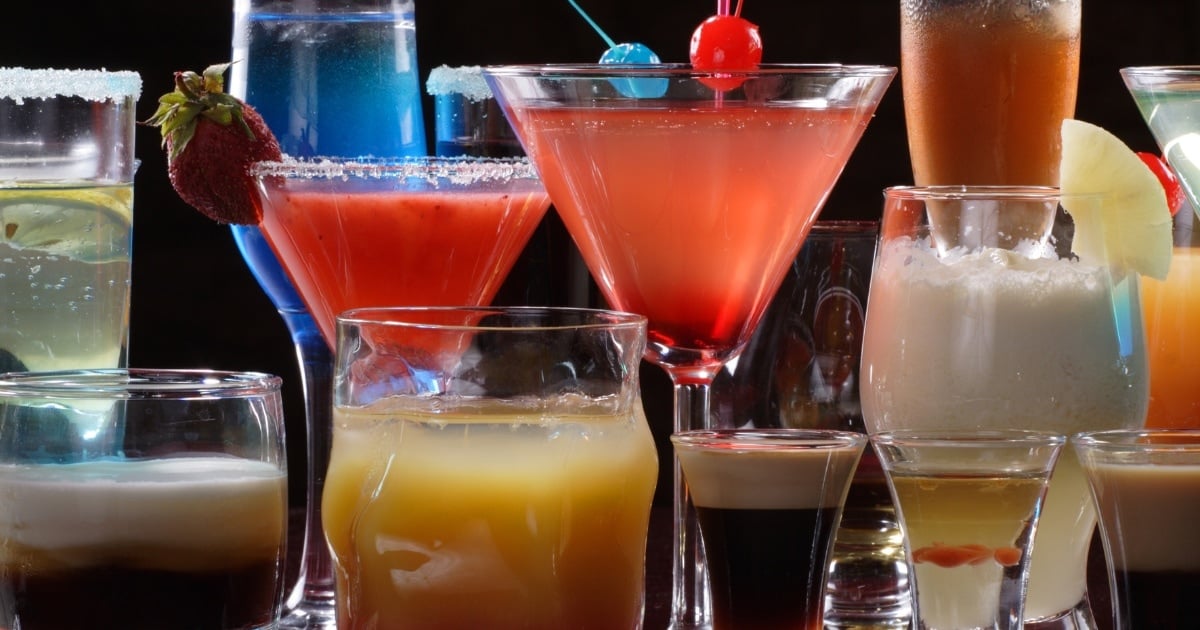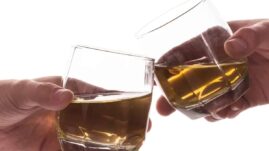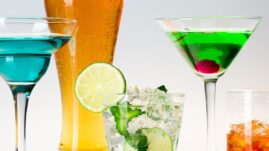Alcoholic beverages can vary widely in their calorie and carbohydrate content, making it important to understand what you’re consuming if you’re watching your diet.
This guide breaks down the nutritional profiles of popular types of alcohol, helping you make informed choices for your health, lifestyle, and any medical conditions.

Key facts
- When choosing an alcoholic beverage, consider not only the serving size, but how many calories and grams of carbohydrate per serving.
- Drink in moderation, which means no more than two servings per day for men and one serving per day for women.
- Talk with your healthcare provider about your alcohol consumption habits, especially if you have a medical condition or take certain medications that could interact with alcohol.
- Mocktails may be alcohol-free, but they can be brimming with calories and carbs. Choose low- or no-calorie options.
Drinking in moderation
If you drink alcohol, it’s important to drink in moderation. But what does “moderation” mean?
To help minimize risks associated with drinking alcohol, the Dietary Guidelines for Americans, 2020-2025 state that adults can choose not to drink or drink in moderation by limiting their intake to two drinks or less a day for men and one drink or less a day for women.
While drinking small amounts of alcohol is generally safe for most adults, some people should not drink alcohol at all. These include:
- People under the age of 21
- Pregnant women
- People with certain medical conditions, such as liver disease
- People who take certain medications that can interact with alcohol
- People who are recovering from an alcohol use disorder
Check with your healthcare provider if you have questions about drinking alcohol.
Alcoholic beverage serving sizes
Whether your favorite beverage is a glass of wine, a bottle of beer, or a fancy cocktail, make sure to know what’s considered one “drink.” The U.S. Centers for Disease Control and Prevention (CDC) defines a standard drink (one serving) as:
- 12 ounces of beer (5 percent alcohol content), which is usually one can or one bottle of beer
- 8 ounces of malt liquor (7 percent alcohol content)
- 5 ounces of wine (12 percent alcohol content), which is the amount poured into a standard wine glass
- 1.5 ounces (a “shot”) of 80-proof (40 percent alcohol content) distilled spirits or liquor, such as gin, rum, vodka, or whiskey
Keep in mind that different alcoholic beverages have varying amounts of alcohol. For example, many craft beers have a higher alcohol content than regular beer. And some wines have up to 15 percent alcohol or even more. Also, the amount of alcohol served to you may not be consistent with the definition of “one serving” of alcohol.
Calories and carbs in alcoholic beverages
It may — or may not — surprise you that alcoholic beverages contain calories, and depending on the drink, carbohydrates (carbs), as well. Granted, some choices are relatively low in calories and carbs.
A serving (5 ounces) of prosecco, for example, has about 120 calories and 4 grams of carbs. A fruity frozen margarita, on the other hand, can weigh in at upwards of 300 calories and 40 grams of carbs.
Let’s take a closer look at the calories and carbs in some of the more popular alcoholic drinks.
Red and white wine
Some of the most common varieties of red wine include Cabernet Sauvignon, Merlot, and Pinot Noir.
A 5-ounce glass of red wine contains, on average:
- 125 calories
- 4 grams of carbs
If white wine, such as Sauvignon Blanc, Chardonnay, or Pinot Grigio, is more to your liking, note that a 5-ounce glass contains, on average:
- 121 calories
- 4 grams of carbs
So, there’s not a big difference, calorie-wise, between red and white wine. Sweeter wines, such as Riesling, Moscato, and Port are slightly higher in calories and carbs.
What about the notion that drinking red wine is good for your heart?
While some studies show that drinking alcohol in moderation may boost HDL (“good”) cholesterol, prevent blood clots, and lower the risk of heart disease, the evidence for red wine fending off heart disease is rather weak, according to Harvard Health Publishing, the media and publishing division of the Harvard Medical School of Harvard University.
Health experts don’t encourage anyone to start drinking wine (or any type of alcohol) for the sake of improving heart health or preventing heart disease.
Champagne and sparkling wine
Prefer a little bubbly to a glass of “regular” wine? Champagne and sparkling wines, such as prosecco and cava, are better choices than most still wines, at least when it comes to calories and carbs.
A 4-ounce glass of Champagne or sparkling wine, contains, on average:
- 78 calories
- 1 gram of carb
(It’s worth noting that while the standard serving size for both still and sparkling wines is 5 ounces, the unique design of sparkling wine glasses may lead to these being filled with slightly less than their still wine counterparts, resulting in the referenced 4-ounce serving size. This is due to both the carbonation in sparkling wines and the shape of the glasses.)
Regular and light beer
Many people’s go-to drink is a bottle or can of beer. Beer is usually made from malted barley, hops, yeast, and water. It can also be made from other grains, such as wheat or rye.
Light beer is beer that contains less alcohol, and therefore, fewer calories than regular beer.
12 ounces of regular beer contains, on average:
- 153 calories
- 13 grams of carbs
12 ounces of light beer contains, on average:
- 103 calories
- 6 grams of carbs
Light beer has soared in popularity, thanks to its lower calorie and alcohol content. It can be a better choice to help you curb your calorie and carb intake. However, regular beer is fine to drink — in moderation, of course.
If your tastes run more toward “heavier” types of beer, such as ale or stout, you might be curious about the calories and carbs in these beverages.
12 ounces of ale contains, on average:
- 153 calories
- 13 grams of carbs
12 ounces of stout contains, on average:
- 176 calories
- 12 grams of carbs
Fancy having a pint of your favorite stout? A pint is 16 ounces, so that will set you back roughly 234 calories and 19 grams of carbs.
Hard cider
Hard cider is not your ordinary apple cider that you pick up at the local farm stand. Instead, it’s an alcoholic drink that is made from fermented apples.
Reaching for a bottle of hard cider instead of a bottle of beer may seem like a healthier choice. But the reality is that, due to the amount of sugar in hard cider, the calories and carbs are generally higher than in beer.
12 ounces of hard cider contains, on average:
- 199 calories
- 22 grams of carbs
If your goal is to limit your calorie and carb intake, beer may be a better choice.
Hard seltzer
Hard seltzer is another popular alcoholic beverage. This beverage consists of flavored carbonated water mixed with alcohol. Hard seltzers may contain alcohol from fermented cane sugar or malted barley. The alcohol content can vary, depending on the brand. Some brands may also contain fruit juice.
A 12-ounce can of hard seltzer contains, on average:
- 99 calories
- 2 grams of carbs
Compared to beer, hard seltzer can be a better choice. Be aware that some brands contain more alcohol than others, and the size of the can may be 16 ounces instead of 12 ounces.
Distilled spirits
Distilled spirits, often called hard liquors, are beverages made from the distillation of grains, fruits, or vegetables. Vodka, rum, tequila, gin, whiskey, and brandy are popular distilled spirits.
A 1.5-ounce serving (one shot glass) of 80-proof distilled spirits contains, on average:
- 97 calories
- 0 grams of carb
From a carb standpoint, distilled spirits can be a better choice than wine or beer. But beware: If you start mixing vodka with chocolate liqueur, or rum with pineapple juice and coconut cream, both the calories and carbs can skyrocket.
To keep the calories and carbs under control, drink your favorite distilled spirit “neat,” meaning, without any water, ice, or mixer, or “on the rocks” (served with ice).
Cocktails
Mixed drinks, or cocktails, are trendy and fun, and often appeal to people who dislike the taste of wine and beer. These drinks can quickly add up in calories and carbs, however, depending on how they’re made and, of course, how much you drink.
Here’s a look at the typical average calories and carbs in a few of the most popular mixed drinks and cocktails:
- 654 calories
- 85 grams of carbs
- 341 calories
- 33 grams of carbs
Moscow mule, 12 ounces:
- 336 calories
- 35 grams of carbs
- 213 calories
- 13 grams of carbs
- 185 calories
- 9 grams of carbs
Mojito, 6 ounces:
- 174 calories
- 24 grams of carbs
- 125 calories
- 7 grams of carbs
Alcohol and low-carb diets
If you’re limiting your carbohydrate intake, you might be curious if alcohol is off-limits. The short answer is “no.”
But, you’ll need to be more careful about the type and amount of alcoholic beverage that you drink. If you count grams of carb, you can fit an alcoholic drink into your daily carb budget as long as you know how much carb is in your drink.
Maybe you’re not strict about counting carbs but prefer to stay away from carb-laden drinks like a chocolate martini, for example. If that’s the case, stick with these beverages:
- Light beer
- Red or white wine
- Sparkling wine
- Distilled spirits (“neat” or mixed with a noncaloric mixer, such as water, seltzer water, or diet tonic water)
Learn more in: The Best and Worst Alcoholic Drinks for People With Diabetes.
Alcohol and the keto diet
The ketogenic (“keto”) diet is a low-carbohydrate, high-fat eating plan that’s used for several reasons, including weight loss, and managing conditions such as diabetes and epilepsy.
While there is no standard amount of carbohydrates mandated by the keto diet, in general, carb intake is limited to between 20 grams and 50 grams daily. Small amounts of alcohol are permitted, but as with a low-carb diet, you’ll need to limit how much and what types of alcoholic beverages you drink.
(And note that alcohol metabolism can temporarily halt ketosis, or the burning of fat for energy instead of glucose. This is because the liver prioritizes breaking down alcohol, which can temporarily pause fat metabolism and therefore affect ketosis.)
Nonalcoholic beer
If you’ve decided to limit or avoid alcohol or are concerned about the carb content of beer, you might consider drinking a nonalcoholic beer.
Nonalcoholic beer isn’t necessarily free of alcohol, however. That’s because, in the United States, nonalcoholic beer is defined as having less than 0.5 percent alcohol by volume (ABV).
Luckily, there are brands of beer that are completely free of alcohol. They often list “0.0” on the label, which means that there is 0.0 percent alcohol by volume.
Buyer beware when it comes to calories and carbs for any nonalcoholic beer, as these can vary widely, brand to brand. Check out the following examples:
Heineken 0.0, 11.2-ounce serving:
- 69 calories
- 16 grams of carbs
Coors Edge Nonalcoholic Brew, 12-ounce serving:
- 41 calories
- 8 grams of carbs
Athletic Lite, 12-ounce serving:
- 25 calories
- 5 grams of carbs
Note that alcoholic/nonalcoholic beverages are exempt from nutritional labeling. If you’re unable to find a Nutrition Facts label on the bottle or can, visit the brand’s website for this information.
Nonalcoholic wine
Nonalcoholic wine is wine that contains little or no alcohol. Like nonalcoholic beer, though, nonalcoholic wine may still contain alcohol. You can find wines that are completely free of alcohol, often called “dealcoholized” wines.
Nonalcoholic wines generally contain between 70 to 90 calories and 14 to 25 grams of carbs per 5- to 8-ounce serving.
Mocktails
Sometimes called virgin drinks, mocktails are cocktails without the alcohol. These can be a good alternative to a cocktail. While a mocktail can simply mean a Bloody Mary without the vodka, other mocktails can be an intricate blend of juices, soda, herbs, and bitters.
One of the most well-known (and still popular) mocktails is a Shirley Temple, made from ginger ale, lime juice, and grenadine, topped with a maraschino cherry. Other common mocktails include virgin mojitos, virgin sangria, virgin mules, and Arnold Palmers (a blend of iced tea and lemonade).
While it’s fun and exciting to celebrate with a mocktail, the fact that they are alcohol-free doesn’t mean they are calorie and carb-free. Here’s a look at some typical average calorie and carb counts:
Virgin margarita, 12-ounce serving:
- 228 calories
- 58 grams of carbs
Shirley Temple, 8-ounce serving:
- 188 calories
- 47 grams of carbs
Mojito mocktail, 8-ounce serving:
- 120 calories
- 32 grams of carbs
You can still enjoy a mocktail without all the calories and carbs. Start with a base of sparkling water. From there, mix with freshly squeezed lemon juice, a splash of cranberry juice, muddled mint leaves, or slices of cucumber, lemon, or lime.
Final thoughts
If you decide to drink alcohol but would like to keep the calories and carbs in check, a glass of Champagne or sparkling wine is your best bet, followed by white or red wine, and then distilled spirits neat, on the rocks, or mixed with a no-calorie mixer.
When it comes to beer, hard cider, hard seltzer, and any kind of cocktail, it pays to do a little research: Read the ingredients and visit the manufacturer’s website for the number of calories and carb grams to help you make a wise decision.
Nonalcoholic beverages are options if you don’t drink alcohol. While these drinks contain little or no alcohol, they generally contain calories and carbohydrates. No- or low-calorie mocktails can be a better alternative.
By staying informed and mindful of your choices, you can enjoy social gatherings and celebrations without compromising your health goals.






Antonio De Luca
Great article, with so many options. Merry Christmas.